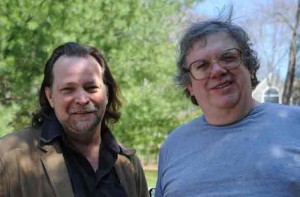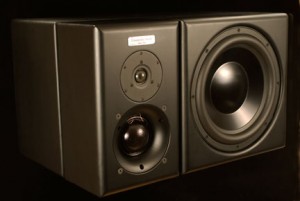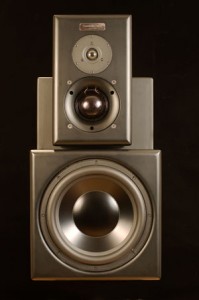Monitor Motivation: Guzauski-Swist Audio Systems
MOUNT KISCO, NY: In lands near and not so very far away something sonic has been brewing. Boutique audio gear manufacturers – from cables to compressors — are proliferating at a nice pace in the New York Metro area, and monitors are no exception.
For multiple GRAMMY-winning mixer Mick Guzauski (Madonna, Michael Jackson, Henry Mancini, Quincy Jones, Mariah Carey, Jennifer Lopez, Christina Aguilera) and studio designer Larry Swist (Tainted Blue Studios, Quad Recording Studios, Eargasm Studios, Cloud 9 Mixing Stages), a near-lifelong musical partnership has led to an ambitious system for critical listening.
This particular brainchild is Guzauski-Swist Audio Systems, producing stereo, 2.1 and 5.1 Surround monitoring systems created expressly to satisfy their own exacting standards. Based upstate in bucolic Mount Kisco, their main offering is the GS-3a active 3-way speaker, which sports an intriguingly flexible design with high performance for both tracking and mixing.
At $12,000/pair (with G-S amp) it’s a more serious investment, but with installs in NYC, Nashville and Rochester, their expectations of an appreciative audience in the market have been validated. Larry Swist explained how the pair’s passion for audio and massive mutual respect made the G-S project – and the daunting challenges of boutique manufacturing — a calling he couldn’t refuse.
What first got you thinking about creating the G-S speakers?
It started with a phone call from Mick. He and I have known each other since we were in our late teens, and back then we were building PA systems and speakers. Mick was doing recording in his basement, and I thought, “This guy’s a savant, I gotta learn what he does and put my bass down.” I fell in love with sound for the first time.
We’ve been working together since then, but we also got our own careers going. I got involved with Spyro Gyra and jazz. He mixed every chick ballad in the world and sold a gazillion copies. But he called me a while back and said, “Are you still into speaker design? I’ve been using the Tannoys, I can’t get them reconed, and they’re running out of gas on me. Are you into it?”
And the answer was, “Yes!” I take it?
It started as a science project. We looked at design philosophies, thinking back over the years, and what were the best speakers we ever heard — boxes, three-way systems – and we came out with a goal of what kind of performance we wanted.
We spent about 18 months trying drivers, amplification processes, DSP, and then we came up with something Mick was willing to put into his control room and put his mixes on. We kind of fell in love with it. It was our child, but the big thing was it sounded great, and everyone’s reaction to it was incredibly enthusiastic.
So we said, “Maybe we can produce these. We’re two audio geeks that have been mixing records and designing studios. We can really do this.” So we’re in that stage of being a company, producing our flagship model the GS-3, and we’ve now got Chris Bubacz involved as a third partner. He’s been in the industry a bunch of years also and brings the organizational structure and business mind to the company.
I’m excited about this company, and I get that way again every time I listen to these speakers. That’s why I got into audio. It had gotten to the point where everything I was hearing was not dynamic enough, or ran out of gas too fast.
Another aspect of that is that Mick mixes in them. They had to have accuracy so they translated, but they also have a robustness so you can also track on them. In a smaller studio, this is the only speaker you’d need – they’re a Swiss Army knife, because they enhance the sound, but you still get all the accuracy out of a speaker that you need to mix on.
As you’ve built up the company, what are you finding out not just about speaker design, but about being a manufacturer?
We learned not to be satisfied. You have to be very uncompromising. You want to be able to say, “OK, let’s just do this the best we can and go on to the next stage.” But you can’t do that. It can be tempting to say, “Let’s use that component, or this one, because it’ll be cheaper,” but Mick’s hearing is a big factor in preventing those decisions. He’s a savant when it comes to that, and I trust him when he says we have to take a certain path to maintain the sound quality.
Of course, Money is always a big issue. Mick and I do other things that bring income in, and then the monitors are what we invest in: buying parts and doing R&D. The frustration comes when you try and market something. Getting something out there when you have the Genelecs of the world to compete with – it’s hard to have the budgets to do that.
We’ve had shootouts with very small groups of people up to this point. It’s gratifying when we do have these demonstrations and they win, but then people need to have the money to buy them. That said, they are a reasonably-priced speaker system compared to Genelecs or ATCs, for example.
How would you characterize the current monitor market that you’re competing in?
There’s the home/project studio that’s always going to have real budget constraints. People get great amps, great mics, great gear, and then listen through something substandard, so they can’t really benefit from all that other equipment. That’s unfortunate, in my opinion, because after the room, the monitors are the most important thing you’re hearing. Keeping this in mind, we believe people will stretch their budgets slightly once they hear our speakers.
I do think there is a market of commercial and high-end personal studio facilities that do a lot of tracking and writing, and are a little more endowed, and these hit that market perfectly. We’re also going after THX certification for the post world. We have all the dynamic and level requirements for good mixing of film and video, especially 5.1.
It seems to me that getting people to switch their main monitors is a pretty big proposition. How do you get people to consider such a drastic change in their setup?
I think you’re absolutely right. Any pro or serious amateur will get to know their monitors after a time, and they adjust their mixing habits accordingly. For example, they’ll know their monitors are down in the low range and so they’ll compensate for that.
When one top engineer heard these monitors in Nashville, he said to us, “I’ve been using ‘X’ monitors and I really understand them, but it would be nice to have monitors like this so that when I go into mastering, I wouldn’t have to hear all the things that I missed!” So for someone who listens on a constant basis, they’d be willing to say, “OK, here’s something that could make my work easier or better.”
I do think that takes a little bit of courage to say, “I’m going to leap from my current monitors to these new ones, especially after having had success with the first ones.” But I think the Guzauski-Swist speakers are enough of a jump above what people are using that they would be willing to make that change.
As you pointed out, you and Mick have been a team for a long time. How would you characterize the chemistry that the two of you have developed?
Mick and I bring slightly different abilities to the table. Mick’s ears are his greatest asset, and he’s respected across the board by his colleagues. But I bring stuff that Mick can’t do: I bring the mechanical end together. I construct prototypes and build very solid working enclosures that are acoustically a jump from something that Mick might not have thought of.
So the respect is back and forth. I’ll refer to what he’s hearing, but he may be looking too closely at something. So the combination is really about mutual respect, his ears and my mechanical abilities.
Does being an NYC area-based manufacturer help and/or hurt your efforts in any significant way?
NYC has a broad range of our potential users. The way we’re marketing these now is to have listening demos in studios, or with anybody who wants to check them out. Just get on our Website and email us, and we’ll arrange a demo.
That’s a big factor in helping these to sell, initially — the sheer amount of people and population here. We’re doing it in L.A., too, but we live here. This is our town. We feel we’re part of the community.
I talk to people all the time who want to take the plunge, and produce the “better mousetrap” that they’ve built – whether it’s cables, limiters, compressors, etc… What advice do you have for someone who wants to get into boutique manufacturing for audio?
The first thing I would do is make sure you have something better than anything else out there. Do something that sounds better, so the music benefits from your efforts. Then it’s worth the agony of what you’re trying to get out there – because you really believe in it.
— David Weiss
Please note: When you buy products through links on this page, we may earn an affiliate commission.









